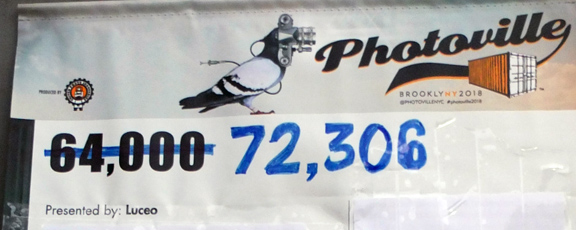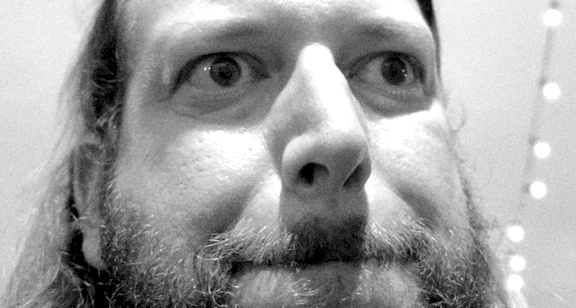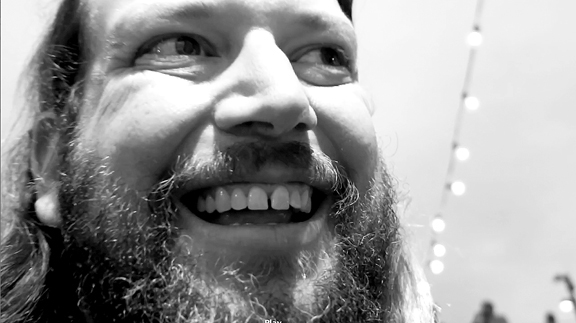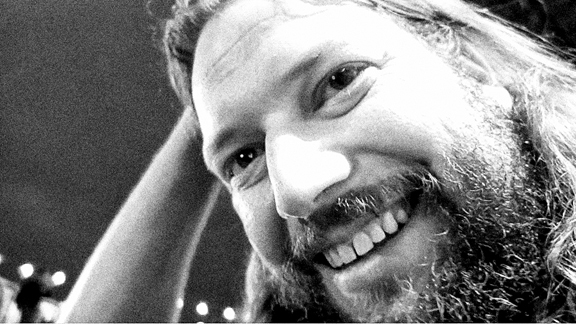h. nazan ışık—
23 September 2018—
I was at Photoville (13-23 September) again, so many events to attend, so many talks to listen, so many projects to see. Walking around from one container to another, all offer powerful images, compelling stories.
But, there was one container by Luceo with a title that has no words, but numbers.
Luceo, founded in 2007, is a creative agency specializing in story-based advocacy and strategic media production. And every year they come with an interesting installment. So I went in.
Without big pictures, but, next to each other, 198 portraits were on the wall. And messages:
“Opioids include heroin and commonly prescribed pain killers”, “Opioids overdose simply means a person stops brathing” , “ Naloxone can reverse the fatal effects of an overdose” etc…
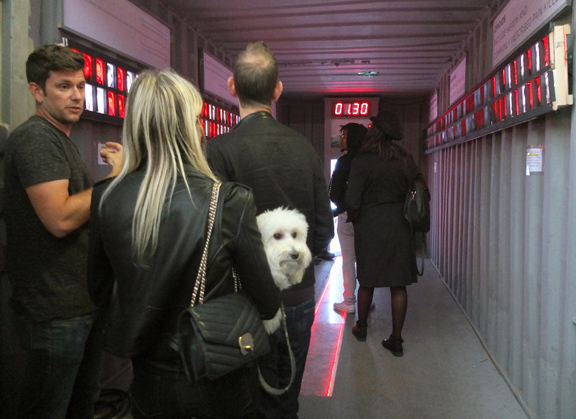
Kevin German, one of the co-founders of Luceo, is talking to a visitor about Luceo project/exibition ‘72,306’ at Photoville. (h. nazan ışık /NKENdiKEN)
Kevin German, one of the co-founders of Luceo, was welcoming visitors and explaining the project.
Kevin German: “198 portraits represent the number of people who die from an overdose in a single day. And 72,306 is the number of people who died in 2017. Right now every seven minutes and 19 seconds a person dies from an overdose in the United States. ”
At the end of the container there was a timer, set to 7 minutes and 9 second.
Kevin German: The timer at the end of the container counts down to the next overdose. When it reaches zero, a single steel bearing, representing a single life falls onto the bell below before passing through the channel on the floor. The floor represents the deaths, to date, in the United States. When the bell rings, a portrait on the wall turns from white to red at random. The effect is cumulative so that at the end of the 24 hour cycle all the portraits are re
On the wall I saw a picture of Kevin too. It was still white.
“How many time did you die so far? I asked.
He looked at his portrait, “Everyday, but for now I am still alive,” he smiled.
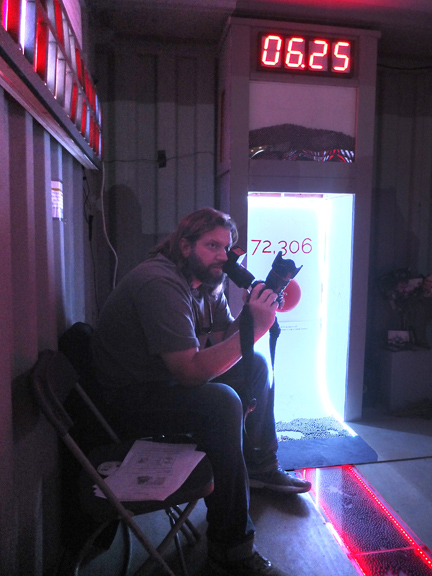
Matt Slaby, one of the co-founders of Luceo, is at Luceo project/exhibition ‘72,306’ at Photoville (h. nazan ışık /NKENdiKEN)
Matt Slaby, another co-founder, was quietly sitting in the back. I decided to talk with him.
h.nazan ışık: What you are offering in your container, which is different that others, not images, but you have messages. Why are you here at Photoville?
MATT SLABY: We started out as magazine photographers. So we believe in the importance of the visual image in terms of telling stories. We come here every year to use Photoville as a test kitchen to figure out something new to illustrate something that we are working on.
We have been doing a lot of work on the opioid crisis, the overdose crisis. That’s why we are here this year.
HNI: Your messages are very informative, your exhibit, your installation is very eye-catching. You are here to reach, to explain your project to visitors. But broadly who is your target?
MS: We are a strategic media agency. We built strategic media for advocacy-based organizations; so that organizations work on drug policy, public health, harm reduction, criminal justice reform. Whit this particular exhibit we advocate for changing, how we work with people who use drugs, to shift out of incarceration base model into a model that is public health base.
HNI: How do you do that?
MS: We have done a lot of work on this particular issue. So some instances we speak to the voters, some instances we speak to law enforcement officials, some instances we speak to politicians, and some instances we speak to like niche communities that are affected by this issues.
Over the course of last nine years we have done this work, we have involved 9 law changes, we have done work in the international level of the UN, we’ve done post change implementations, so ones the law signs into law, we have also done media that is built around how we implement the law, that just passed.
We talked about the dead penalty that Trump suggested for drug dealers, and users.
“This does NOT work” he sad.
HNI: What do you advocate?
MS: I believe and that is supported by data, people use drugs, they always have used drugs. Of that group of people who use drugs, there are certain things we can do to minimize the risk of that behavior. No different than when we get into a car we wear a seat belt, or when we get into a construction side we put on a helmet.
We can do certain things to reduce, to eliminate the spread of HIV, or Hepatitis C infection. And will reduce, if not eliminate fatal overdose. All those three things are preventable by how we administer public health.
Sterilized syringe costs only 9 cents. And treatment costs $80,000 – $90,000. 9 cents vs $90,000!
Conversation got deeper. We talked about who is making how much from that $90,000????
MS: Overdose as well is preventable by medicine called Naloxone. Naloxone can reverse the effect of the overdose.
HNI: (I interrupted him) Yes, but that person needs someone to give the medicine. What if there is no one near, or there is someone near, but no Naloxone?
MS: Overdose, it is not that person’s heart stop working, it is lack of oxygen. One can give rescue breathing while waiting for emergency medical help.
HNI: Are you suggesting that one should let someone know that he/she is going to take drugs?
MS: (He smiled) It is always safer to take drugs where people are, like public places or with friends.
I always interrupted him with different questions, like if a person is using drugs in a public palace with 3-4 restrooms, how one can know that someone needs help? Or, how about alcohol? We see a lot of advertisements in magazines or on TV, but no signs/ warnings that it harms you…
MS: Because they are socially accepted, not opioids.
Of course it opened doors to more questions. Who wouldn’t want those warning signs on TV commercials???
HNI: There is last question I would like to ask: If you were I, what would you ask Matt Slaby?
MS: (He looked surprised first) That is a tough question.
HNI: In other words what else would you like to say, add?
MS: (He smiled,) I know, I know. The last thing, we don’t have supervised use site in the United States. This is the gold standard really how we address the overdose epidemic and people who use drugs.
Supervised use site is a place someone uses drugs in front of a trained professional. And there are 102 of these things operating worldwide in 63 different countries, and there has never been a fatal overdose in one of these facilities. They are incredibly effective in preventing overdose, and also way effective in offering stability.
HNI: You always come to Photoville with very interesting installations, very different than other containers. Last year it was ”Designing the White”. How long does it take to create a presentation?
MS: Thank you. It depends on the year. The idea is more important that the presentation. For us what is important is to decide how do you want to show that idea.
It was a very pleasant, informative, and deeper, broader than what their title ‘72,306’ offers conversation.
Looking forward to seeing Luceo’s presentation for next year’s Photoville.
Photos: © h. nazan ışık /NKENdiKEN
© h. nazan ışık

